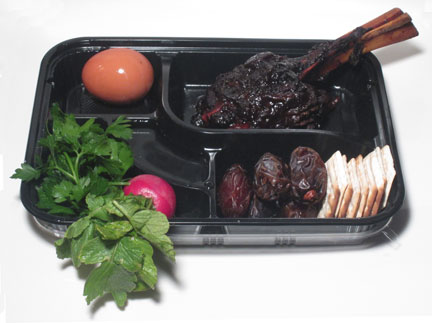The story goes that while fleeing the land of Egypt, the ancient Israelites didn’t have time to wait for their dough to rise, which in turn created the first matzah. Every year for the Seder, we serve this matzah, alongside
a perfectly arranged ceremonial plate filled with symbolic foods to help us recount the miraculous story of our ancestors’ survival.
The image of Israelites fleeing reminded me of the Jews constantly moving from one place to another. I thought about the modern Jew who takes off for vacation to enjoy Passover week with his family in sunny places. Images of full Seder dinners in take-out trays on airplanes or ordered from a menu online came to mind. I imagined Chinese restaurants taking Passover orders on the phone, delivering dry white rice in white cardboard containers (for Sephardim only!), or even better, Japanese restaurants delivering ceremonial plates in Bento Box containers (Box A: Egyptian, Box B: Syrian…) all for the constantly moving Jew on the go.
Below is the description that one Egyptian man shared with me about his Seder plate while growing up in Alexandria:
BOX A:
THE EGYPTIAN CEREMONIAL SEDER PLATE
KORBAN (Pesach Sacrifice):
Lamb Shank Bone
KORBAN CHAGIGAH / BEIT’ZAH (Festival Sacrifice):
Hardboiled Egg (whole with shell, or cut into pieces)
KARPAS (Green Spring Vegetable):
Swiss Chard
MAROR (Bitter Herb):
Romaine Lettuce Leaves
CHATZERET (2ND Bitter Herb):
Radish (dipped in black pepper)
TEARS & SWEAT OF ENSLAVED JEWS:
Small Bowl of Salt Water
CHAROSET:
Whole fresh dates dipped in ground walnuts and hazelnuts
MATZAH:
Softened slightly with water

